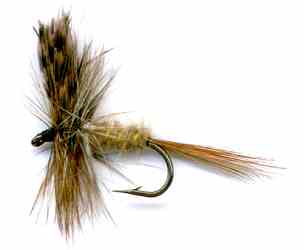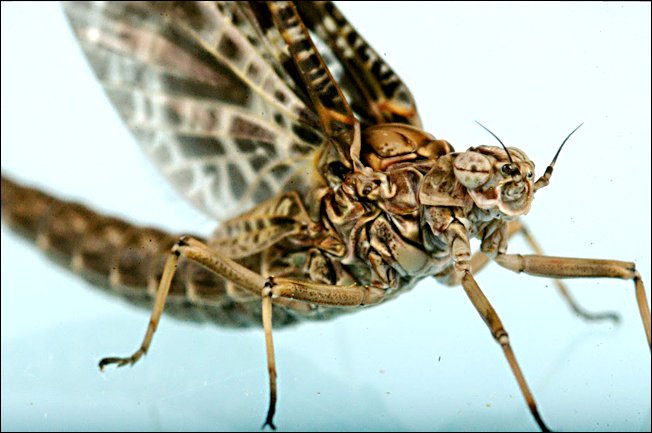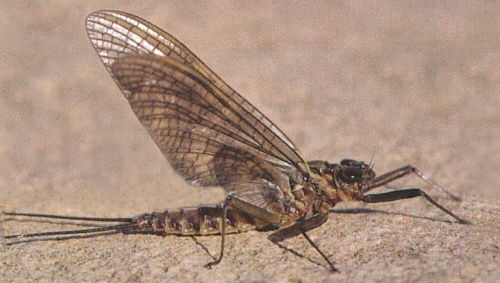The March Brown Dry Fly
It is peculiar that this pattern should include the month of March in it's name since the natural insects are not confined to hatching in this month. These flies represent the two different insects that are commonly given the same name: the March Brown (Rithrogena Germanica, its old scientific name was Rithrogena Haarupi) and the Late (or False) March Brown (Ecdyonurius Venosus).

DRY FLY PATTERNS. Hook size 10 12 14 16 18 20 - $US each
The March Brown likes large stony rivers just like stoneflies. This is why in England it is completely unknown on the Southern Chalkstreams and stillwater lakes or ponds. Hatches are often on a grand scale in the middle of a spring day. The March Brown pattern is one of the oldest angling flies around. Look for hatches of the March Brown in the late spring just after lunch time. The Late March Browns hatch in early summer after the March Brown hatch. It is slightly larger and far less numerous than its earlier hatching insects. Some years may bring a late season hatch if there is hot weather. It is the emerging nymphs of this mayfly that are regularly eaten by trout, but duns and egg laying female spinners are also taken.
After hatches of tiny midges and Blue winged olives the March Browns are normally the first large mayflies of the year. They always seem to hatch in cold rainy afternoons. They can hatch from mid February and continue into May. If you are in the water earlier in the day try floating a few nymphs like the Gold Ribbed Hare's Ear or a larger Pheasant Tail near the bottom and as the morning develops present them nearer and nearer the surface as the nymphs float upwards ready for the hatch. As soon as you see surface rises switch to a dry fly. The Autumn Dun (Ecdyonurus dispar) is often confused for the March brown insect as the two are of similar size and appearance. It also favors stony or boulder-strewn rivers as well as the shores of stony lakes.

You can use a March Brown Dry fly to imitate the Speckled Dun Mayfly (Callibaetis). It is one of the larger mayflies and prefer slow weedy sections of ponds, lakes and rivers.
The duns emerge during the day from mid to late summer. Treat your fly with floatant and let it drift on the water surface with the current or use small jerks to impart the appropriate movement of a struggling drowning fly. You can also let it sink slowly moving only slightly to indicate the insects dying twitches. When these floating fly patterns come on the water they evoke considerable interest from the fish. These big flies do their best work where rivers and lakes are bordered by heather or trees. Remember you are trying to imitate a drowning land based insect. There are a number of variations on the standard pattern. We have found the bigger hook sizes were more productive in catching trout.
The March Brown pattern has been tied by fly fishers over the centuries. As far back as the 1600's it is recorded as being a fly pattern of choice in England. The fly is known by many different local names like Brown Drake, Dun Drake or Cob Fly. This fly pattern unusually works when there are no hatches. It seems to function as a universal attractor pattern for dark insects. G.E.M. Skews wrote "..is an excellent fly and as generally tied, quite a poor imitation of the natural fly and quite a passable one of almost anything else." The nymph remains at the bottom of the river bed for over two years undergoing a series of moults as it grows. It has a flattened body which appears broad in proportion to its length. It is large and dark in colour. A large Gold Ribbed Hares Ear Nymph or a Pheasant Tail nymph is an ideal choice as a match for the March Brown Nymph.. The natural nymph can swim but spends most of its time sheltering under rocks and stones at the bottom of the river or stream bed. It feeds mainly on algae in these relative safe locations and is only in danger of being eaten if it is disturbed. Wriggling Salmon, laying eggs in the gravel can abruptly force the March Brown Nymph into open water where it has to quickly find a new home. Trout and Steelhead lurking downstream to catch stray eggs will also gobble up unfortunate March Brown Nymphs.

I like to use a Soft Hackle Spider fly to replicate the action of the Early March Brown nymph swimming to the surface. Either side of the hatch I often use one as a top dropper on a rig of three with two other nymph patterns down below. The takes do not tend to be as splashy and quick as the trout have realized that the crippled, drowning and trapped insects are not going to suddenly fly away. So they can take their time. I try to drift these rigs over areas of fish activity with regular 'dead drift'. On reaching the surface the the nymph case is held in the water film as the dun emerges, pumps blood to its new wings, dries quickly and then flutters off into the air. A Suspender Buzzer is ideal as a imitation of this stage in its life cycle. The False or Late March brown nymph crawls from the river to the land to hatch. As soon as the hatch appears I switch to the dry fly. Look out for bird activity as a great indicator that it has started.
I have noticed that on the first few days of the hatch for some strange reason the fish seem to stick to the smaller olives and shy away from the bigger march Browns so I always have a few BWO's handy. They soon get over this fear and happily feast on the bigger flies. If the hatch occurs in fast flowing water some of the duns will drown and trout can be taken on a March Brown Wet Fly. The dun has brown mottled wings where as the later spinner has lighter nearly transparent wings. The males swarm close to the water and after mating the female returns to the water surface to deposit the eggs. The adult males are rarely taken by fish. It is these egg depositing females that are looked upon as a good meal by trout. Trout being opportunists feeders will take struggling spent spinners of both sexes, caught in the surface film.
CUSTOMER'S COMMENTS
I fly fish in Minipi, Labrador in Canada and use the March Brown Dry fly on a big hook from mid June to early July to imitate the Small mayfly and then until the end of July to match the Brown Drake. John Brook
CUSTOMER'S COMMENTS
I fish the Pequest River in New Jersey. It is the stretch that flows from the spillway that leaves the Pequest hatchery. The top trout catching dry flies are your March Brown dries. Tight Lines Dude, Fred Ungaretta NJ,USA


Fly Fishing books

